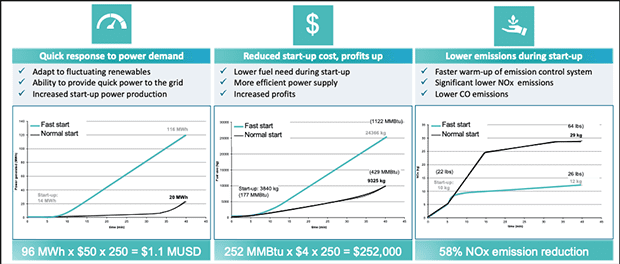Today’s heat recovery steam generators (HRSGs) are suffering reliability problems, mainly because they’re being operated in the cycling mode instead of the baseload mode for which they were designed. The good news is HRSG suppliers are adapting to the market demands and are designing the next generation of HRSGs to have cycling-friendly—also called fast-start—features.
One of the market trends that is forcing HRSGs into the cycling mode is the mandate for more renewable energy plants. Why does that affect HRSGs? Because a typical daily electricity-demand curve shows a morning peak and an evening peak. However, these peaks in demand don’t correspond with the output of renewable energy sources, which fluctuate based on natural changes in the winds and the sun’s position in the sky (Figure 1). This intermittent and stochastic nature of renewable energy creates an imbalance in the electricity grid, which must be stabilized by other power plants—a rigorous job that falls primarily on the shoulders of gas-fired combined cycles.
 |
| 1. Combined cycle plants must operate in the cycling mode to match the fluctuating demand curve. Courtesy: Siemens Heat Transfer Technology |
To fill the renewables shortfall and maintain grid balance, combined cycle plants must:
- Be very flexible to keep up with the fluctuating demand curve.
- Be able to withstand daily starts and stops.
- Be able to ramp up and throttle down to meet demand as quickly as possible.
In the coming years, renewable energy plants are expected to supply even more electricity to the grid, so tomorrow’s combined cycle plants must be designed to be even better at these three needs than today’s combined cycles. With this goal in mind, Siemens Heat Transfer Technology—the Siemens division formed from the acquisition of NEM Energy—developed the DrumPlus HRSG.
The DrumPlus HRSG combines the fast-start characteristics of a once-through steam generator with the benefits of a conventional drum-type HRSG—namely, greater operator familiarity with the water-chemistry regime and better tolerance of chemistry upsets. In the DrumPlus HRSG, the high-pressure steam drum’s diameter and wall thickness are minimized by splitting up the important function of water-steam separation into two stages, with the second stage occurring in bottles outside the steam drum (Figure 2).
 |
| 2. A second stage of water-steam separation occurs in bottles outside the drum in Siemens’ new DrumPlus technology. Courtesy: Siemens Heat Transfer Technology |
Another unique feature of the DrumPlus HRSG is that the two exterior downcomers in today’s evaporator section have been replaced by interior downcomers, which further improves flexibility and lowers thermal stresses. The DrumPlus HRSG is already in commercial operation at the El Segundo combined cycle project in California and is under construction at nine other combined cycle projects worldwide. According to Siemens, this design will increase the service life of the HRSG by as much as seven times, compared to today’s typical, high-pressure drum-type HRSG.
In addition to these engineering benefits, there are economic and environmental benefits of the DrumPlus HRSG. Specifically, it will yield greater electricity sales and fewer air emissions simply because it will complete each startup faster. For instance, during the first 40 minutes of startup with today’s HRSG, the typical F-class plant generates approximately 20 MWh. In comparison, during the first 40 minutes of startup with a DrumPlus HRSG, the typical F-class plant will generate approximately 116 MWh—nearly six times more.
The faster startup will also warm up the selective catalytic reduction (SCR) system faster, so it will begin reducing NOx emissions sooner. Siemens projects that NOx emissions from tomorrow’s F-class plant will be reduced by 58%, compared to today’s plant (Figure 3).
 |
| 3. Benefits of the fast-start DrumPlus HRSG. Courtesy: Siemens Heat Transfer Technology |
The future is unpredictable, of course, but the mandate for renewables seems here to stay and probably will grow stronger. As a result, tomorrow’s combined cycle plants will need fast-start HRSGs—such as the Siemens DrumPlus design—if they are going to remain competitive and productive for many years to come.
—Rob Swanekamp, PE is executive director of HRSG User’s Group Inc. This article includes information from a presentation given by Marlon Farquharson of Siemens Heat Transfer Technology at the 2019 HRSG User’s Group Conference
https://www.powermag.com/next-generation-hrsgs-start-fast-and-reduce-emissions/